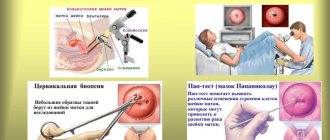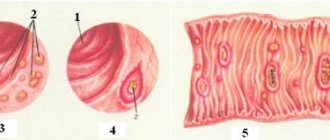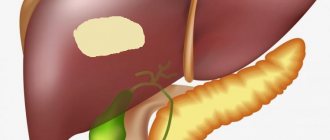What is uterine inflexion and where does it come from?
In a normal position, the body and cervix form an obtuse angle directed forward. In this case, deviation can be observed in any direction: back, forward, left and right.
About every fifth woman faces the problem of improper placement of the uterus. Most often, in about 70% of cases, this organ is bent forward or backward.
Among the most common causes of a bent uterus:
- weakness of the ligaments that support the uterus;
- frequent inhibition of the urge to defecate and empty the bladder;
- constipation;
- difficult childbirth, complicated by muscle rupture;
- adhesive process that developed after inflammatory diseases;
- ovarian cysts, tumors of the bladder, colon;
- abortions resulting in inflammation;
- hard physical labor, excessive physical activity in the fitness club;
- endometriosis;
- uterine tumors (fibroids, fibroids, leiomyomas).
Also, the bend can be congenital and accompanied by underdevelopment of the uterus.
https://youtu.be/6KE-b5bTsZ0
Features of diagnosis and treatment
Typically, anteflexio is detected during a gynecological examination of the genitals. If the gynecologist doubts his preliminary diagnosis, he sends the woman for a pelvic ultrasound. Ultrasound examination allows us to reveal the full picture of the pathology. If the ultrasound results confirm that the uterus is located in anteflexion, the specialist will prescribe appropriate treatment.
In cases where the cause of anteflexio is inflammatory and infectious processes, the doctor prescribes physical therapy and medications (anti-inflammatory drugs and antibiotics) to the woman.
If the cause of anteflexion is adhesions, the patient is offered laparoscopy. With such surgical intervention, the position of the organ is restored quite quickly and easily, and the risk of injury is minimal. After 7–10 days, the woman returns to her usual way of life.
An integral component of therapy for anteflexio is special gymnastics aimed at strengthening the pelvic floor muscles. An excellent help in eliminating this problem are exercises according to the Kegel technique. A woman first learns the exercises under the guidance of a specialist (physiotherapist), and then performs them independently at home.
If there is a slight bend and difficulties with conception, it is recommended to adhere to certain positions during sexual intercourse. If the uterus is in a pathological anteflexion position, the woman should be positioned in a supine position.
Symptoms of a bent uterus
Sometimes the bend of the uterus does not make itself felt at all. But in some cases it manifests itself with the following symptoms:
- menstrual irregularities, which are expressed in the appearance of severe pain, heavy bleeding and prolonged spotting before menstruation;
- discomfort during sexual intercourse;
- constipation (the bend of the uterus can put pressure on the rectum and interfere with its emptying);
- miscarriage;
- infertility.
Particularly acute pain can be felt with a combination of bending and rotation (twisting of the uterus), which causes compression of the fallopian tubes. In this case, the pain can be aching, dull, or vice versa - sharp, radiating to the rectum or lower back.
When the uterus is bent, pain can also be caused by long walking, standing or a sudden change in body position - for example, when getting up from a chair after a working day.
All women who want to have a normal sex life and plan to give birth to a healthy baby must undergo a gynecological examination and rule out the presence of a uterine flexion. Considering the frequent asymptomatic nature of this pathology, it doesn’t hurt to get checked even if there are no complaints!
Causes
In gynecology, there are cases of congenital deviation of an organ from its normal position. In this case, treatment tactics are determined based on the degree of inversion and concomitant diseases. Acquired anteflexio occurs when an abortion is performed incorrectly. Additional provoking factors:
- The presence of chronic infectious diseases of the pelvic organs. Pathogens that can lead to similar consequences include ureaplasma, mycoplasma, chlamydia, gonorrhea, gardnerella, trichomonas, etc.
- Difficult or complicated childbirth, occurring with cervical ruptures and heavy blood loss.
- Injuries to the genital organs in accidents.
- The formation of adhesions in the pelvis during a prolonged course of the inflammatory process.
- Consequences of surgery. Pathology can be the result of improperly performed diagnostic curettage, cauterization of cervical erosion, laparoscopic surgery, etc.
- Excessive physical activity. This is especially true for women who are interested in bodybuilding and other types of strength training.
Endometriosis, which grows into the cervix and body of the uterus, can provoke a bend in the front. Weak tone of the ligamentous apparatus, which supports the organ in a normal position, can also contribute to the occurrence of anteflexio. Additional causes: intestinal pathologies, chronic inflammation of the ovaries and malignant tumors.
A slight change in the position of the uterus is not pathological if there are no characteristic symptoms and problems with conception.
The congenital form of the disease requires treatment only in extreme cases, when a woman complains of pelvic pain and discomfort during sexual intercourse.
Treatment of a bent uterus
If a uterine inclination is detected, the doctor will give recommendations on limiting heavy lifting and physical activity. For example, you can choose those types of fitness that in your case will not be harmful.
The following treatment methods are also used:
- taking medications;
- gynecological massage, which increases the elasticity of adhesions if present and normalizes blood circulation in the pelvis;
- physical therapy for training intimate muscles;
- vitamin therapy;
- phytotherapy;
- physiotherapeutic procedures.
In especially severe cases, surgical intervention is resorted to to cut adhesions and fix the uterus in the correct position.
Diagnostics
Features of the clinical picture do not allow diagnosis without ultrasound and colposcopy. Additionally, a smear is taken to identify concomitant infectious pathologies. Most often, anteflexio is recognized during a gynecological examination. If the doctor is in doubt, he sends the patient for an ultrasound examination, which allows not only to identify the pathology, but also to determine the degree of bending of the uterus and possible consequences.
Minor deviations from the norm may not be detected by the gynecologist during a standard examination. However, the presence of a pathological process is indicated by a number of symptoms that help in making a diagnosis: disruptions in the menstrual cycle, pain in the lower abdomen that worsens during menstruation, infertility. Often, in addition to ultrasound, the doctor finds adhesions, endometriotic lesions and other provoking factors of the pathological process.
How to prevent
To prevent the risk of developing anteflexion, every woman should follow the following recommendations for the prevention of the disease:
- It is necessary to visit a gynecologist twice a year and undergo a full examination of the pelvic organs.
- Avoid physical inactivity and overeating.
- Physical activity should be moderate.
If the examination reveals infectious or inflammatory diseases of the genitourinary system, it is necessary to immediately begin their treatment in accordance with the recommendations of a specialist. It is advisable to have one reliable sexual partner to eliminate the risk of sexually transmitted diseases.
Not the least place is given to proper nutrition. Maintaining a healthy diet will help prevent constipation or digestive and intestinal problems that can contribute to the development of anteflexio.
Many women, having heard a diagnosis of uterine anteflexion at an appointment with a gynecologist, ask the question: what does the position of the uterine body anteflexio mean and why is such a pathology dangerous? Is it possible to get pregnant with such a diagnosis, carry and give birth to a baby? How is anteflexion treated?
If the uterus is in anteflexion from birth, that is, it is a congenital pathology, then the degree of dysfunction of the organ will depend on the degree of deviation. However, if the position of the uterus anteflexio is acquired, then this problem should be given special attention by starting timely treatment.
Prevention
To prevent pathological deviation of the uterine body from its normal position, you need to undergo a timely examination by a gynecologist. Other preventive measures:
- refusal of unprotected sexual contact;
- use of barrier contraception as a method of protection against STD infection;
- prevention of sexual infantilism in childhood and adolescence (nutrition, dosed physical activity, medical examination by a gynecologist);
- limiting physical activity when lifting weights.
Pathological curvature of the uterus will not prevent a woman from becoming pregnant if she promptly seeks qualified medical help.
Symptoms
This pathology is dangerous because in a mild form it almost does not manifest itself. Therefore, many women learn about the disease when anteflexion already begins to cause significant discomfort along with acute pain.
The symptoms of anteflexio versio of the uterus are pronounced if the pathology occurs as a result of adhesions. In such a situation, the uterus may be immobilized, and the adhesions themselves hold it in a certain position, which may be accompanied by severe pain. Typically, such a pathology is expressed in the form of the following series of symptoms:
- The appearance of disruptions in the menstrual cycle.
- The occurrence of frequent urge to urinate.
- The occurrence of acute pain in the lower abdomen during menstrual periods.
- The appearance of a feeling of discomfort against the background of intimacy, and sometimes just while walking.
- The occurrence of periodic pain in the groin area.
Symptoms of the uterus
This pathology is dangerous because in a mild form it practically does not manifest itself. Therefore, many women learn about the disease when anteflexion of the uterus causes significant discomfort and acute pain.
Test: How good is your health?
Symptoms of anteflexio are pronounced if the pathology arose as a result of an adhesive process. In such a situation, the uterus becomes immobilized, adhesions hold it in a certain position, which is accompanied by pain.
Typically, such a disease is expressed by the following series of symptoms:
- menstrual cycle irregularities,
- frequent urge to urinate,
- sharp pain in the lower abdomen during menstrual periods,
- a feeling of discomfort during intimacy, and sometimes just when walking,
- periodic pain in the groin area.
With an acquired diagnosis, 90% of patients experience problems conceiving a child. The resulting bend prevents sperm from entering the fallopian tubes and uterus, which leads to the inability to become pregnant naturally.
Features of diagnosis and treatment
Typically, anteflexio is detected during a gynecological examination of the genitals. If the gynecologist doubts his preliminary diagnosis, he sends the woman for a pelvic ultrasound. Ultrasound examination allows us to reveal the full picture of the pathology. If the ultrasound results confirm that the uterus is located in anteflexion, the specialist will prescribe appropriate treatment.
In cases where the cause of anteflexio is inflammatory and infectious processes, the doctor prescribes physical therapy and medications (anti-inflammatory drugs and antibiotics) to the woman.
If the cause of anteflexion is adhesive processes, the patient is offered laparoscopy. With such surgical intervention, the position of the organ is restored quite quickly and easily, and the risk of injury is minimal. After 7-10 days, the woman returns to her usual way of life.
An integral component of therapy for anteflexio is special gymnastics aimed at strengthening the pelvic floor muscles. An excellent help in eliminating this problem are exercises according to the Kegel technique. A woman first learns the exercises under the guidance of a specialist (physiotherapist), and then performs them independently at home.
Also, for therapeutic purposes, the doctor may prescribe the use of vaginal balls or wearing a special bandage.
If there is a slight bend and difficulties with conception, it is recommended to adhere to certain positions during sexual intercourse. If the uterus is in a pathological anteflexion position, the woman should be positioned in a supine position.
What does it mean that the uterus is tilted anteriorly?
Women often face the problem of being unable to conceive a child. This can be caused by various chronic or inflammatory processes in the genital organs. However, what to do if a woman is absolutely healthy, but childbearing is not carried out. The cause may be an abnormal position of the uterus.
Bend of the uterus is diagnosed quite often today; this pathology does not have characteristic symptoms. This means that a violation of the location of the cervix and body of the uterus can be detected only with careful diagnosis. With this diagnosis, there is some difficulty in getting pregnant on your own.
So, if the organ is deviated anteriorly or posteriorly, then there is a significant difficulty in the flow of sperm to the mature egg. But this does not mean that a patient with such a diagnosis should despair; today there are many techniques that help eliminate uterine bending.
Let's take a closer look at this problem and determine the best methods to solve it.
The concept of bend
The normal anatomical location of the organ is anterior to the bladder.
This means that in this case an obtuse angle should form between the body of the organ and its neck, which is called “anteflexio” in gynecology.
In this position, normal access of sperm to eggs is maintained during their fertilization. The angle between the axis of the vagina and the cervix should also be obtuse - this physiological position is called “anteversio”.
There are several anomalies of uterine bending:
- deviated anteriorly - in this case, the body of the organ is strongly deviated forward and an acute angle is formed between it and its neck;
- deviated posteriorly - this means that the body of the uterus strongly deviates back towards the rectum, an angle of 900 is formed between the cervix and the body;
- deviated to one side towards the ovary - the disposition of the uterus.
A change in position can occur when the bladder or rectum is full. This means that diagnostics should be carried out only after complete emptying. Also, a change in the position of the uterus can be caused by relaxed pelvic muscles.
https://youtu.be/AAWjrCGJcpA
Normally, the body of the organ should be located in the center of the female pelvis, at an equal distance between the navel, pubic part and sacrum.
As a rule, bending is considered to be a congenital pathology, but this does not mean that a woman cannot get an acquired form of the disease.
In most cases, women experience the so-called excessive form of bending anteriorly - into the bladder area. With this pathology, both the cervix and the organ itself are deviated. In rare cases, there are patients whose uterus is so deviated anteriorly that the angle between the cervix and the body of the uterus is no more than 20°.
So, when the uterus is tilted anteriorly - what is it? This is a pathological process in which the cervix and body of the uterus are deflected anteriorly towards the bladder and they form an acute angle between themselves.
Causes and symptoms
In the case of a hereditary form of uterine bending, we can talk about an abnormal course of pregnancy or a violation of the embryonic development of the fetus during the formation of the genital organs.
This form of pathology does not make itself felt until the first visit to the gynecologist, which means that the patient may not even be aware of such a problem.
With this diagnosis, you can become pregnant naturally and bear a healthy child. Congenital uterine flexion occurs in only 15% of women.
In the case of an acquired form of bending, it is worth talking about the problems that cause it:
- weakening of the muscles and ligaments of the pelvis (occurs in multiple pregnancies and complications during childbirth), the deviation can be anterior or posterior;
- chronic inflammatory processes in the pelvic area and its organs. This means that with such a problem, many adhesions are formed, due to which the uterus can change its position;
- adhesions after surgery;
- tumor formations that lead to displacement;
- significant weight loss in a short period. This means that the uterus can also change its position, but when returning to normal body weight, it returns to the correct position;
- pathology of the rectum, which can lead to anterior deviation of the uterus;
- if a girl likes to wear high heels, this means that the center of the body axis can shift and lead to an anterior position of the uterus.
Also, factors that can provoke death include constant stress and nervous tension, unsuccessful consequences of a medical abortion, and disturbances in the production of hormones in the body. This means that with the slightest changes in the full functioning of the body, you need to seek advice from a specialist.
Unfortunately, it is impossible to identify the bending of the uterus on your own, since this pathology does not give characteristic symptoms. Only when faced with the problem of the inability to get pregnant can a woman be diagnosed with an abnormal location of the uterus.
If the uterus is tilted anteriorly or posteriorly, the patient may experience an irregular menstrual cycle, pain during urination and sex, and bowel movements. When faced with any of these problems, you need to contact a specialist who will conduct an examination and determine the true cause.
Diagnostic methods
When examined by a gynecologist, it may be revealed that the uterus is deviated from its normal location. To do this, the doctor palpates the deviation of the uterus - diagnosis is not difficult.
With such a bimanual examination, it is possible to determine the correct shape and size of the uterus and the location of the ovaries.
If the doctor understands that it is deviated anteriorly or posteriorly, then an additional ultrasound examination is performed, which confirms or refutes the diagnosis.
Possibility of getting pregnant
Deviation of an organ from its normal anatomical location is not a cause for concern if the woman has already had pregnancies, and she learned about the anterior bending of the uterus after childbirth. With this diagnosis, a woman can become pregnant on her own and bear a healthy child. If pregnancy does not occur during bending, the doctor recommends following some tricks:
- If the uterus is tilted anteriorly, then the ideal position for conception is considered “missionary”. In this case, the woman lies on her back, the angle between the uterus and the cervix is leveled, which means that access for sperm is open.
- If it is deviated posteriorly, then the ideal position for a woman would be “lying on her stomach.” In this case, the angle is also leveled and the fertilization of the egg is unimpeded.
If the uterus is tilted anteriorly, it is recommended that a woman place a pillow under her hips during sex so that the uterus takes a physiological position.
After intimacy, it is recommended to lie quietly for a few minutes and not rush to get up, then take the “birch tree” position - legs and pelvis raised up.
Often during pregnancy, the deviated uterus eventually returns to its normal anatomical position.
If the uterus is tilted anteriorly, the likelihood of spontaneous miscarriage increases. This means that the bending of an organ can provoke termination of pregnancy at any stage. In this case, the patient is prescribed a course of special antispasmodic drugs, a bandage in the later stages, and physical therapy. Sometimes a woman is prescribed long-term bed rest.
Very often, bending during pregnancy is accompanied by isthmic-cervical insufficiency. This means that if the organ is deviated, the cervix does not perform an obturator function and a miscarriage can occur at any time. In this case, drug treatment is carried out and the pregnant woman is placed in a hospital for preservation.
Thus, anterior bending of the uterus is not an obstacle to the desired pregnancy.
This pathology can be identified by examination by a doctor.
It is he who will suggest successful positions for conception that will help a woman find the happiness of motherhood. In some cases, the deviation is eliminated surgically, but such an operation is performed only in the presence of pathologies.
In general, women with this diagnosis lead normal, full lives.
Treatment
In cases where the causes of anteflexio are inflammatory and infectious processes, doctors prescribe physical therapy to women along with medications (usually anti-inflammatory drugs and antibiotics).
When the cause of anteflexion is adhesive processes, patients are offered laparoscopy. With this surgical intervention, the position of the reproductive organ is quickly and easily restored, and the risks of injury are minimal. Within ten days, women return to their usual lifestyle.
An integral component of treatment in the presence of anteflexio is special gymnastics aimed at strengthening the pelvic floor muscles. An excellent help in eliminating this problem are various exercises according to the well-known Kegel technique. Women first learn the exercises under the guidance of a qualified specialist (physiotherapist), and then perform them independently at home.
In addition, for therapeutic purposes, the doctor prescribes the use of vaginal balls along with wearing a special bandage. If there is a slight bend and difficulties with conception, it is recommended to maintain a certain position during sexual intercourse. If the uterus is in such an unusual position, the woman should lie on her back.
We looked at what anteflexio of the uterus means. Knowing the characteristics of this disease, you can make timely attempts to get rid of it or reduce its manifestations.
Types of bend
Pathological options include the following types of abnormal location of the internal genital organs in the pelvis:
- retroversion (the body of the uterus is displaced posteriorly, and the cervix is displaced anteriorly);
- anteversion (the uterus is anterior and the cervix is posterior);
- dextroversion (uterus to the right, cervix to the left);
- synistrosia (uterus to the left, cervix to the right).
The most unpleasant thing with any of these options will be the degree of bending between the uterus and cervix. The sharper the angle between these anatomical formations, the more pronounced the bend and the worse the situation with possible gynecological pathology.










